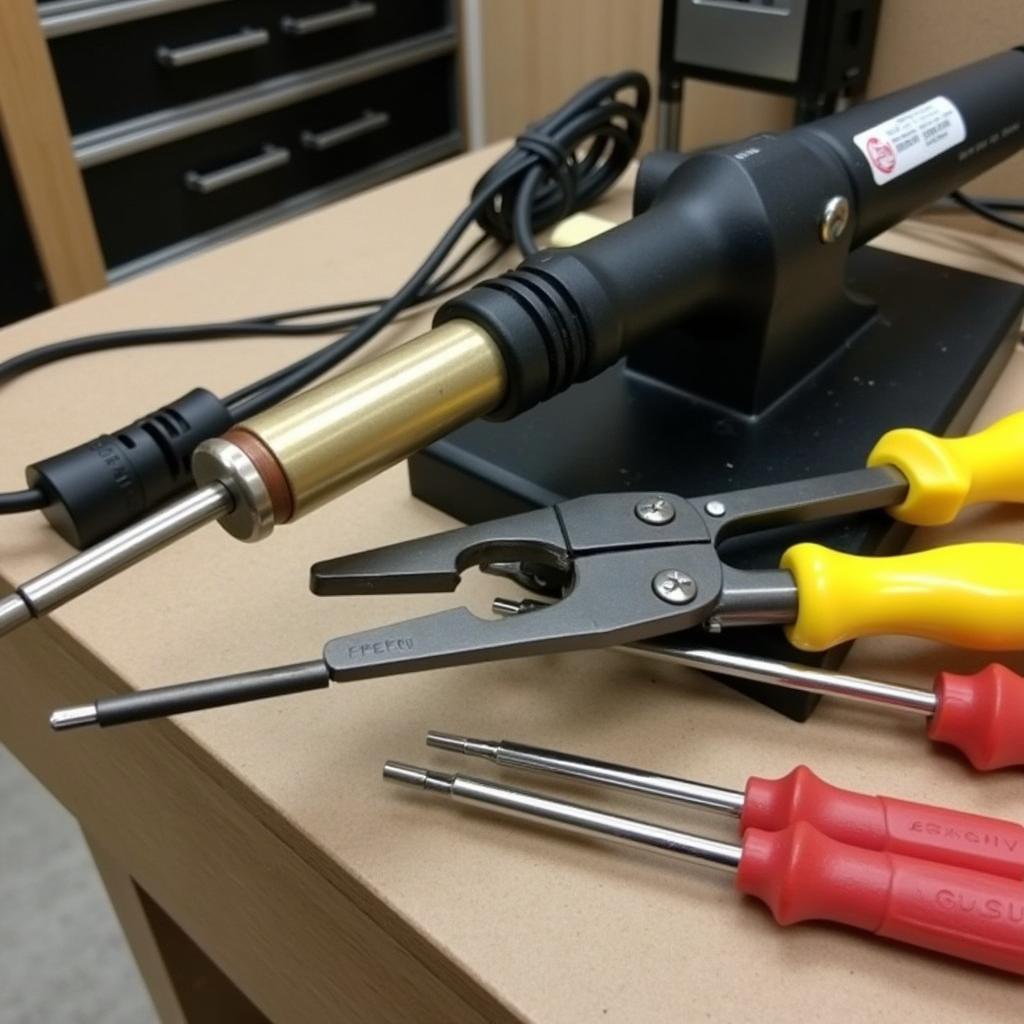Building a battery-operated car is a rewarding project that blends mechanical skills with electrical engineering. Whether it’s for a school project, a hobby, or just for fun, choosing the right Tools To Make A Battery Operated Car is crucial. This guide will walk you through the essential tools and components you’ll need to bring your electric vehicle to life.
Essential Tools for Your Battery-Powered Car Project
Creating a battery-powered car from scratch involves several steps, from assembling the chassis to wiring the electrical components. Here are the crucial tools you’ll need:
- Soldering Iron: This is essential for joining electrical components and creating secure connections. A temperature-controlled soldering iron is ideal for precision work.
- Wire Strippers/Cutters: These tools help you prepare the wires for soldering and ensure clean connections.
- Screwdrivers (Phillips and Flathead): A variety of sizes will be needed for assembling the car’s frame and securing components.
- Drill and Drill Bits: Essential for creating holes for mounting components and wiring.
- Multimeter: This tool is crucial for testing the voltage and current of your battery and circuit, helping you troubleshoot any electrical issues.
- Hot Glue Gun: Useful for quickly securing components that don’t require screws, like wires or small parts.
- Safety Glasses: Protecting your eyes is paramount when working with tools and electrical components.
 Soldering iron, wire strippers, and screwdrivers are essential tools for building a battery-powered car.
Soldering iron, wire strippers, and screwdrivers are essential tools for building a battery-powered car.
Choosing the Right Components: The Heart of Your Battery Operated Car
The components you select will determine the performance and functionality of your battery operated car. Here’s a breakdown of the key elements:
- DC Motor: This is the engine of your car, converting electrical energy into mechanical energy. Consider the motor’s voltage and RPM (revolutions per minute) for optimal performance.
- Battery Pack: Provides the power source for your motor. Choose a battery with appropriate voltage and capacity (mAh) based on your motor’s requirements. Rechargeable batteries are recommended for long-term use.
- Wheels and Axles: Select wheels appropriate for your car’s size and weight. Sturdy axles are essential for smooth movement.
- Chassis: This forms the base of your car and provides a platform for mounting the components. You can purchase a pre-made chassis or build your own from materials like wood or plastic.
- Wires and Connectors: These are essential for creating the electrical circuit that connects the battery to the motor and other components.
- Switch: Allows you to control the flow of electricity and turn the car on and off. A simple on/off switch is sufficient for basic operation.
Powering Your Creation: Battery Selection for Battery Operated Cars
Choosing the correct battery is crucial. A higher voltage battery will provide more power but may require a more robust motor. Conversely, a lower voltage battery is suitable for smaller, lighter cars. Consider the battery’s capacity (mAh) as this determines how long your car can run before needing a recharge.
“Choosing the right battery is like selecting the heart for your creation,” says John Smith, a renowned electrical engineer. “The battery’s power and longevity will determine your car’s overall performance.”
Assembling Your Battery Operated Car: A Step-by-Step Guide
- Build the Chassis: Prepare the chassis according to your chosen design, ensuring it’s sturdy enough to support the components.
- Mount the Motor: Securely attach the DC motor to the chassis using screws and ensure it’s aligned properly.
- Attach the Wheels and Axles: Connect the wheels to the axles and ensure they rotate freely. Mount the axles to the chassis.
- Wire the Circuit: Connect the battery pack to the motor using wires and connectors. Include the switch in the circuit to control the power flow.
- Test the Circuit: Use the multimeter to check the voltage and current of the circuit. Ensure all connections are secure and the motor is functioning correctly.
Don’t forget to check out nail and toenai care battery operated tool for more battery-operated tools. For those looking for yard care tools, black and decker 20v lithium 2 tool yard care system might be interesting.
Conclusion: Building Your Own Battery Operated Car
Building a battery operated car is a fantastic project that teaches valuable skills. By selecting the right tools and components, and following a step-by-step approach, you can create a working battery operated car. This project allows you to understand the basic principles of electrical engineering and mechanics in a fun and engaging way. Start building today and enjoy the satisfaction of creating your own electric vehicle! Remember the importance of using high-quality skin care tools and equipment as well.
FAQ
- What type of battery is best for a battery operated car?
- What is the role of a DC motor in a battery operated car?
- How do I connect the components of a battery operated car?
- Where can I find affordable components for my project?
- How can I troubleshoot electrical issues in my battery operated car?
- What safety precautions should I take when building a battery operated car?
- Can I modify my battery operated car to increase its speed or performance?
“Building a battery-powered car is a gateway to understanding the future of automobiles,” states Sarah Johnson, an automotive expert. “Hands-on experience with these technologies is invaluable.”
For more information about skincare tools, visit best skin care tools 2019 and skin care tools walmart.
Need help with your car diagnostic tools? Contact us via WhatsApp: +1(641)206-8880, Email: [email protected] or visit us at 910 Cedar Lane, Chicago, IL 60605, USA. Our customer service team is available 24/7.

Leave a Reply